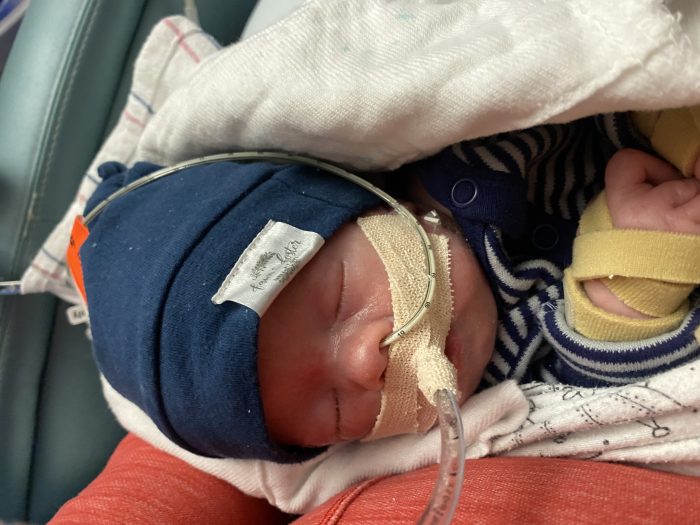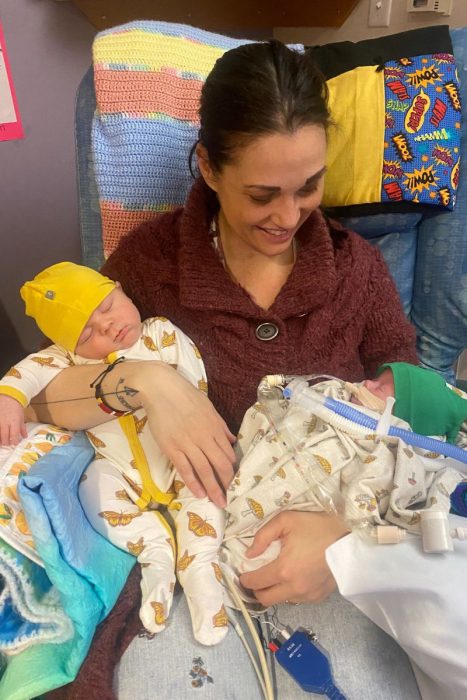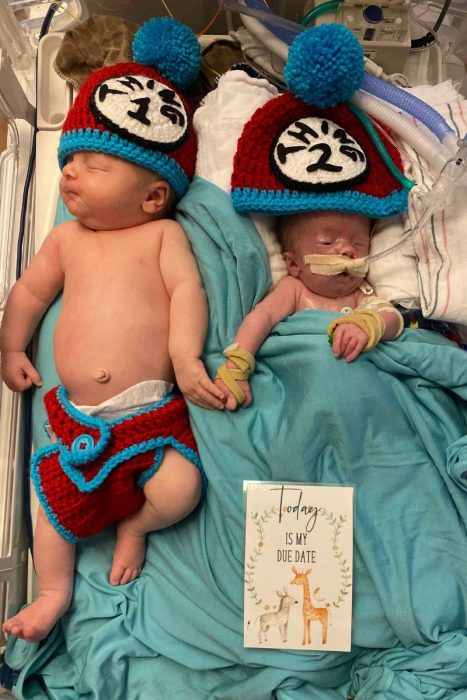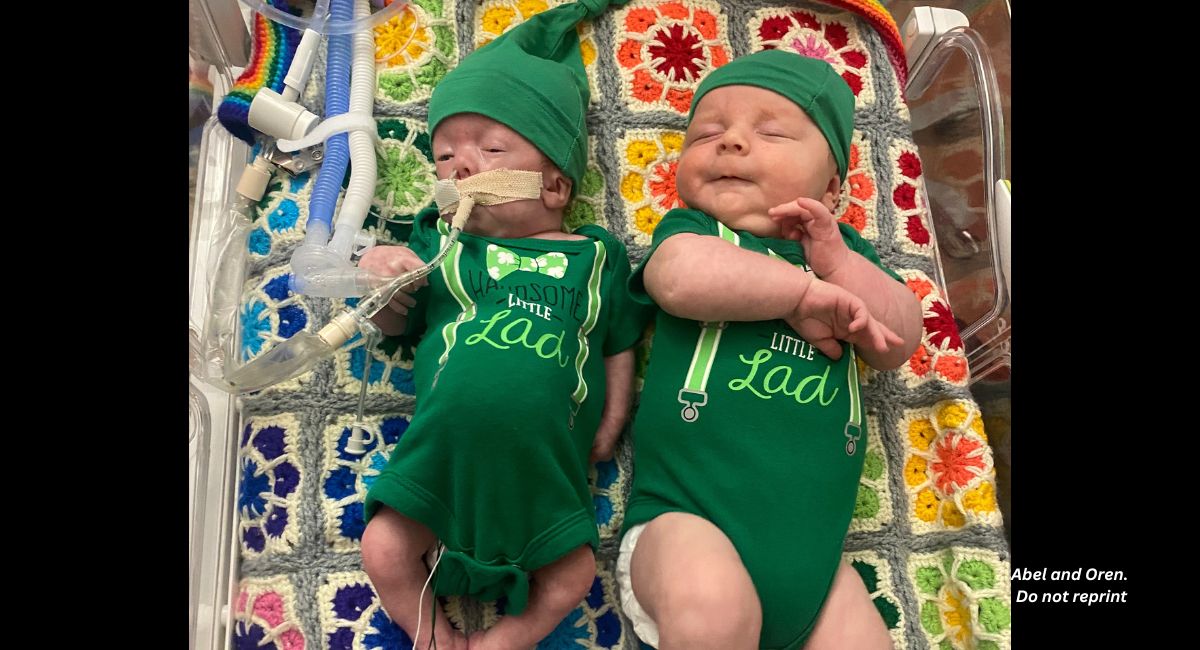Following one woman’s announcement that she had to “escape” from Texas to undergo an abortion in California in order to end the life of one of her twin babies, another mother experiencing a similar situation — but who made a choice for life instead — is speaking out.
In February, National Public Radio (NPR) published a story on Lauren Miller and the heartbreaking diagnosis she received for one of her preborn twins. While one twin was considered healthy, the other was diagnosed with Trisomy 18, also known as Edward’s syndrome. Miller turned to the internet, where she read that 90% of babies with Trisomy 18 die before birth and that those who do survive to birth only live for a few days at most. This information is inaccurate at best.
The genetic counselor told Miller that each day that her son with Trisomy 18 continued to live, he was putting both his twin and Miller at risk. Pro-life laws in Texas now protect nearly all babies from abortion, but, the genetic counselor explained that in pro-abortion states, an abortionist would do a “single fetal reduction.” In other words, they would kill the “unhealthy” baby by lethal injection. The dead baby would then remain in the uterus with the living twin. But death by abortion is not a “treatment” for any preborn child’s health condition.
Miller was told, “Look, this baby is not going to make it to birth” — and that information, coupled with extreme morning sickness, led her to choose abortion in California at 15 weeks. Her son with Trisomy 18 received a lethal injection. She sobbed when it was over.
Research shows that women who choose abortion following a fetal diagnosis have worse mental health outcomes than women who carry to term. Miller had been misled about Trisomy 18 and made a life-ending decision because of it.
Refusing selective reduction for baby with Trisomy 18
In a very different turn of events, seven weeks ago, a different family — Jessie and her husband Matt — welcomed twins whom they had adopted as embryos.
Created as part of another woman’s IVF process, the two embryos were labeled ‘high-level mosaic and complex abnormal.’ While such labels often mean the embryos are destroyed, the biological mother of these embryos wanted to ensure they were not destroyed or left frozen. She wanted them to have a chance at life, so she allowed them to be adopted by others as embryos.
Jessie and Matt, already parents of five children through both natural pregnancy and adoption, knew that the babies might have health conditions, and seeing the value in their lives, decided to adopt them.
At 12 weeks, they learned that one of the twins — named Abel — had an abdominal wall defect. Doctors pushed the couple to do further testing, but the couple opted to watch the defect as Abel grew. An MRI revealed that some of Abel’s organs were located outside of his body in an omphalocele, a ‘bubble’ on his abdomen. They also learned that he had a hole in his heart and that his lungs were small.

Baby Abel. Do not reprint.
“[The doctors] tried to warn me, ‘You can definitely reduce [selective reduction abortion]’ and I even had one doctor say to me, ‘Your baby’s not going to live for very long. Maybe just minutes.’ And I said, ‘Well okay, then I’ll have the minutes with him’,” Jessie told Live Action News. “I always cut them off pretty quickly if they ever started talking about reduction or termination.”
At 33 weeks, doctors became concerned when they noticed a large amount of amniotic fluid in Abel’s sac. Jessie was advised that the babies would need to be delivered or she could have a reduction of amniotic fluid to give her babies a chance to remain in the womb for a few weeks longer. She and her husband opted to have fluid removed and wait until 36 weeks to deliver the babies to help ensure the other twin — Oren — didn’t have to go to the NICU.
Two liters of amniotic fluid were removed, and the doctors tested that fluid for chromosomal abnormalities. The results showed that Abel had Trisomy 18. In the three weeks leading up to the twins’ birth, Jessie reached out to other parents of children with Trisomy 18 and learned how much hope there is for children like Abel.
“That’s what I just held onto,” she said. “There’s still hope. They don’t know everything until the baby’s born. The doctors only know so much in utero. They tell you all of these things but it’s all ‘could have, might have’ and so they don’t know 100% until the baby’s born.”

Jessie, Oren, and Abel. Do not reprint.
They were then given two options following the boys’ births. The first was to provide Abel with only comfort care — letting him die without supplemental oxygen or medical support. The other option was intervention — giving Abel the support he would need to survive.
“Comfort care is what most parents that have a baby with Trisomy 18 are talked into doing,” Jessie said. “That’s why the statistics for babies with Trisomy 18 are so crappy because, one — they are told to abort, or two — they’re told to have the baby prematurely because… this is what they told me: ‘You want to meet him, right? He could die in utero so we might as well just deliver now.’ Three — they do comfort care, which they don’t give them any treatment or oxygen. They just lay them on your chest and see how long they live. Most of them need oxygen. They need something more.”
The twins were delivered at 36 weeks, and Oren defied the diagnosis placed on him as an embryo — he was without any ‘abnormalities’. Abel, with Trisomy 18, needed assistance — and Jessie and Matt decided on full intervention for him.
He has been doing very well and with each week he survives, the family celebrates. “He’s doing great. He’s getting better. He’s growing. He’s doing awesome,” she said.
Instead of looking at him as a diagnosis, the couple treats the health issues Abel has. Neither the hole in his heart nor the omphalocele has proven to be a problem. The omphalocele is so small it won’t require surgery.
“We have some good doctors but it’s really hard because you don’t really know who to trust,” said Jessie. “Because a lot of times when they tell you things, you wonder, because they say things like, ‘Well because of his diagnosis, because of Trisomy 18’ and we have made it really clear with our doctors that that will not fly at all. We are like, ‘No, you can’t blame the diagnosis.'”
If Abel requires treatment or surgery that a child without Trisomy 18 would receive without question, then his parents work to ensure he will get that treatment and not be discriminated against. However, the cardiologist at the hospital where Abel currently is has been refusing to treat the hole in Abel’s heart — a procedure that is routinely done for other children.
Abel’s records have been sent to four other hospitals in hopes of finding a doctor who won’t discriminate against him.

Twins Oren and Abel. Do not reprint.
Jessie believes NPR’s story about Lauren Miller is tragic. “Today I was holding both of my babies in my arms and thinking to myself, ‘This is what she missed.’ Even if she could only hold them together for a week or a day or one time, ‘This is what you missed. You missed the chance to meet this child,” she said. “And that’s just tragic.”
90% of children with Trisomy 18 live when given proper medical care
Trisomy 18 is overwhelmingly categorized as “incompatible with life.” But this isn’t the case. Faith, Melody, Kayden, and Bella have all survived with Trisomy 18. What parents who receive such a diagnosis need to know is that there are doctors willing to give children with Trisomy 18 the medical support they need.
Dr. Marty McCaffrey is one such doctor, and he sought to learn why some children with so-called “fatal fetal abnormalities” were actually surviving. What he learned was that ‘lethality begets lethality,’ which essentially means if children with Trisomy 18 and other trisomies are expected to die, they will die — because no one offers them medical care to live.
“Compassionate doctors who love children even if they are disabled is why our daughter Faith is alive today at 14 years old and thriving with Trisomy 18,” Brad Smith told Live Action News.
He added, “Lauren Miller was lied to by doctors who said her child wouldn’t make it to birth and lied to by online search results which give completely false statistics of 90% death rates. The only 90% death rate Trisomy 18 children face is the 90% abortion rate at which they are killed in the womb simply because they are disabled.”
The Smith family was thankfully able to find help for their daughter. “We have found wonderful doctors at the University of Michigan Mott Children’s Hospital who do not discriminate against our daughter because of her disability,” said Smith. “Faith is included in a Michigan Medicine study which shows 90% of Trisomy 18 children live when they receive proper medical care. It’s never ok to discriminate against disabled children whether it comes from a doctor or parent. These children deserve to be loved and cared for.”







